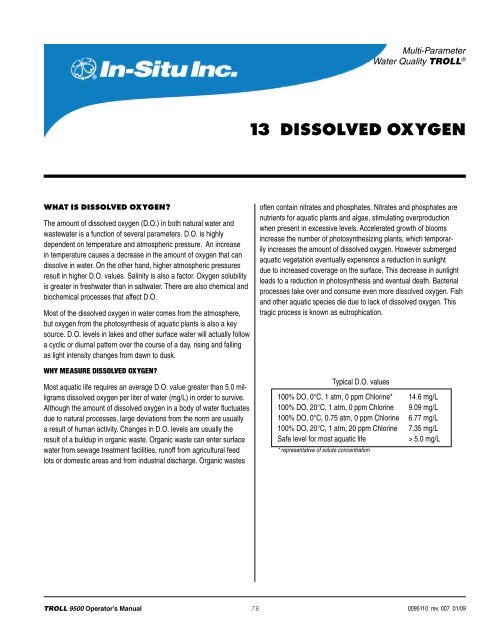TROLL 9500 Operator's Manual - Geotech Environmental Equipment
TROLL 9500 Operator's Manual - Geotech Environmental Equipment
TROLL 9500 Operator's Manual - Geotech Environmental Equipment
Create successful ePaper yourself
Turn your PDF publications into a flip-book with our unique Google optimized e-Paper software.
Multi-ParameterWater Quality <strong>TROLL</strong> ®13 Dissolved OxygenWhat is Dissolved Oxygen?The amount of dissolved oxygen (D.O.) in both natural water andwastewater is a function of several parameters. D.O. is highlydependent on temperature and atmospheric pressure. An increasein temperature causes a decrease in the amount of oxygen that candissolve in water. On the other hand, higher atmospheric pressuresresult in higher D.O. values. Salinity is also a factor. Oxygen solubilityis greater in freshwater than in saltwater. There are also chemical andbiochemical processes that affect D.O.Most of the dissolved oxygen in water comes from the atmosphere,but oxygen from the photosynthesis of aquatic plants is also a keysource. D.O. levels in lakes and other surface water will actually followa cyclic or diurnal pattern over the course of a day, rising and fallingas light intensity changes from dawn to dusk.Why Measure Dissolved Oxygen?Most aquatic life requires an average D.O. value greater than 5.0 milligramsdissolved oxygen per liter of water (mg/L) in order to survive.Although the amount of dissolved oxygen in a body of water fluctuatesdue to natural processes, large deviations from the norm are usuallya result of human activity. Changes in D.O. levels are usually theresult of a buildup in organic waste. Organic waste can enter surfacewater from sewage treatment facilities, runoff from agricultural feedlots or domestic areas and from industrial discharge. Organic wastesoften contain nitrates and phosphates. Nitrates and phosphates arenutrients for aquatic plants and algae, stimulating overproductionwhen present in excessive levels. Accelerated growth of bloomsincrease the number of photosynthesizing plants, which temporarilyincreases the amount of dissolved oxygen. However submergedaquatic vegetation eventually experience a reduction in sunlightdue to increased coverage on the surface. This decrease in sunlightleads to a reduction in photosynthesis and eventual death. Bacterialprocesses take over and consume even more dissolved oxygen. Fishand other aquatic species die due to lack of dissolved oxygen. Thistragic process is known as eutrophication.Typical D.O. values100% DO, 0°C, 1 atm, 0 ppm Chlorine* 14.6 mg/L100% DO, 20°C, 1 atm, 0 ppm Chlorine 9.09 mg/L100% DO, 0°C, 0.75 atm, 0 ppm Chlorine 6.77 mg/L100% DO, 20°C, 1 atm, 20 ppm Chlorine 7.35 mg/LSafe level for most aquatic life> 5.0 mg/L* representative of solute concentration<strong>TROLL</strong> <strong>9500</strong> Operator’s <strong>Manual</strong>780095110 rev. 007 01/09
















